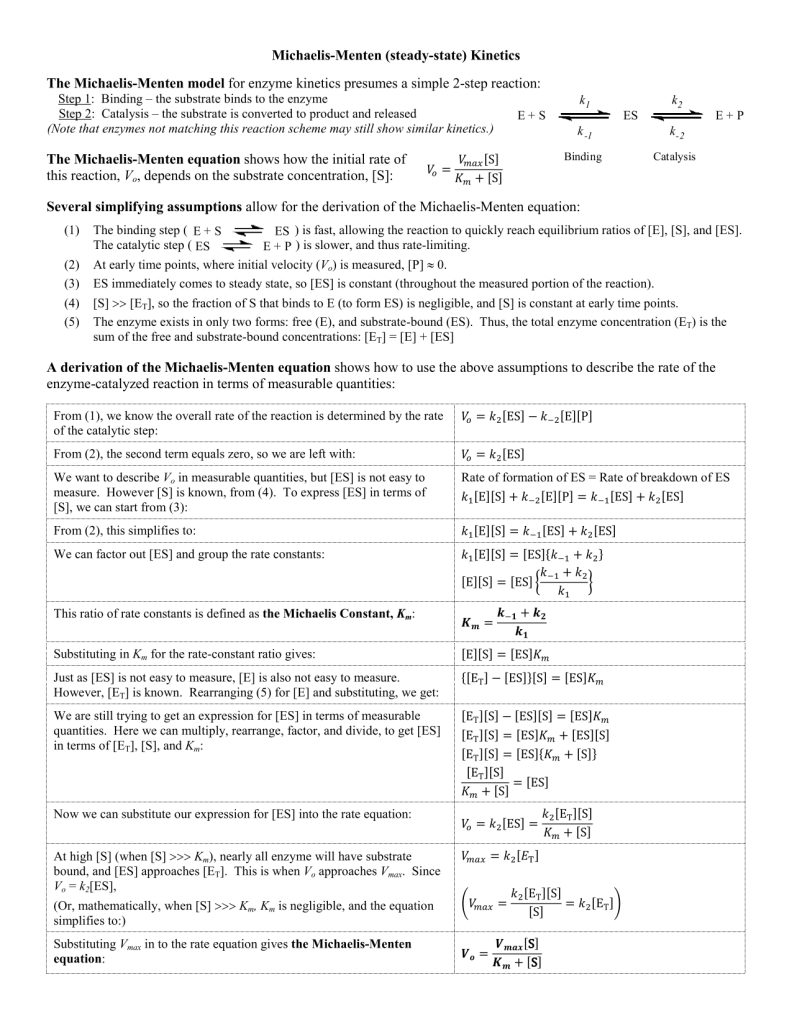Introduction:
The Michaelis-Menten equation was developed in 1913 by German biochemist Leonor Michaelis and Canadian physician Maud Menten, two biochemists working in Germany at the time. They were studying the kinetics of enzyme-catalysed reactions, and their work led to the development of the Michaelis-Menten equation.
To test their model, Michaelis and Menten performed experiments on the enzyme invertase, which catalyses the hydrolysis of sucrose into glucose and fructose. They measured the initial rate of the reaction under different concentrations of substrate and enzyme and found that the rate increased with increasing substrate concentration, but eventually plateaued at a maximum rate. They also found that increasing the enzyme concentration increased the initial rate of the reaction.
Michaelis and Menten then used their experimental data to derive a mathematical equation that described the relationship between the rate of the reaction, the concentration of the enzyme-substrate complex, and the concentration of the substrate. This equation became known as the Michaelis-Menten equation.
The discovery of the Michaelis-Menten equation was a significant breakthrough in the field of biochemistry and enzyme kinetics, as it provided a quantitative model for understanding the behaviour of enzyme-catalysed reactions.
The Michaelis-Menten equation remains a fundamental tool in enzymology today and is widely used in research and industry.
Derivation:

Fig: Michaelis-Menten (steady-state) Kinetics
Michaelis constant (Km):
The Michaelis constant (Km) is a fundamental parameter in enzyme kinetics that describes the affinity of an enzyme for its substrate. It is defined as the substrate concentration at which the reaction rate is half of the maximum rate (Vmax) and is represented by the Michaelis-Menten equation:
v = Vmax [S] / (Km + [S])
where v is the reaction rate, [S] is the substrate concentration, and Km is the Michaelis constant.
Km is a measure of the substrate concentration required for an enzyme to reach half of its maximum activity. It is an indicator of the affinity of an enzyme for its substrate, which reflects the strength of the interaction between the enzyme and substrate molecules. Enzymes with a low Km have a high affinity for their substrate, meaning that they can achieve significant reaction rates even at low substrate concentrations. Enzymes with a high Km have a lower affinity for their substrate and require higher substrate concentrations to achieve significant reaction rates.
Km is an important parameter in enzyme kinetics because it provides valuable information about enzyme efficiency, regulation, and physiological relevance. Enzymes can be regulated by altering their affinity for their substrate, which is reflected in changes in Km. In addition, the determination of Km can be used for drug design and the optimization of enzyme-based industrial processes.
Interpretation of Michaelis-Menten Equation:
- The maximum reaction rate (Vmax) is the rate at which the reaction proceeds when all of the enzyme molecules are bound to substrate molecules. In other words, it is the limiting rate of the reaction when the concentration of the substrate is very high.
- The Michaelis constant (Km) is a measure of the affinity of the enzyme for the substrate. It represents the substrate concentration at which the reaction rate is half of the maximum rate. Enzymes with a high Km have a low affinity for the substrate, while enzymes with a low Km have a high affinity for the substrate.
- The Michaelis-Menten equation shows that the rate of the reaction depends on the concentration of the substrate. At low substrate concentrations, the rate is proportional to the substrate concentration, but at high substrate concentrations, the rate approaches a maximum value (Vmax).
- The Michaelis-Menten equation assumes that the reaction follows a simple two-step mechanism, involving the formation of the enzyme-substrate complex and the conversion of the complex into product and enzyme. The equation provides a quantitative model for understanding the kinetics of enzyme-catalysed reactions and can be used to determine kinetic parameters such as Vmax and Km.
Physiological Significance of Michaelis Constant:
The Michaelis constant (Km) is a fundamental parameter in enzyme kinetics that describes the affinity of an enzyme for its substrate. It represents the substrate concentration at which the reaction rate is half of the maximum rate (Vmax).
The physiological significance of the Michaelis constant can be summarized as follows:
Enzyme efficiency: The Michaelis constant is an important indicator of enzyme efficiency. Enzymes with a low Km have a high affinity for their substrate and can achieve a significant reaction rate at low substrate concentrations. This means that enzymes with low Km can catalysed reactions efficiently even when substrate concentrations are low.
Enzyme regulation: Changes in the Michaelis constant can affect the regulation of enzyme activity. Enzymes can be regulated by altering their affinity for their substrate, which is reflected in changes in Km. For example, competitive inhibitors bind to the active site of an enzyme and increase the apparent Km of the enzyme by reducing its affinity for the substrate.
Physiological relevance: The Michaelis constant can be used to determine the physiological relevance of an enzyme. Enzymes with a low Km and a high Vmax are physiologically relevant because they can catalyse reactions efficiently at low substrate concentrations. Conversely, enzymes with a high Km and a low Vmax may not be as important in physiological processes because they require high substrate concentrations to achieve significant reaction rates.
Drug design: The Michaelis constant is an important parameter for drug design. Many drugs work by inhibiting enzymes, and the effectiveness of these drugs is often determined by their ability to bind to the active site of the enzyme and alter its affinity for the substrate, as reflected in changes in Km.
References:
- Kou, S.C., Cherayil, B.J., Min, W., English, B.P. and Xie, X.S., 2005. Single-molecule michaelis− menten equations. The journal of physical chemistry B, 109(41), pp.19068-19081.
- Srinivasan, B., 2022. A guide to the Michaelis–Menten equation: steady state and beyond. The FEBS journal, 289(20), pp.6086-6098.
- Keleti, T., 1986. Basic enzyme kinetics. Budapest: Akademiai Kiado.
- Bisswanger, H., 2019. Practical enzymology. John Wiley & Sons.
